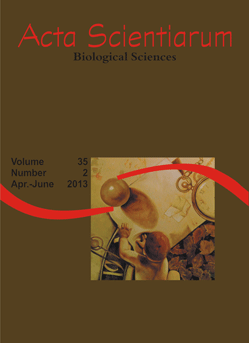<b>Influence of environmental quality on the diet of <i>Astyanax</i> in a microbasin of central western Brazil</b> - doi: 10.4025/actascibiolsci.v35i2.15570
Keywords:
environmental degradation, streams, ichthyofauna, food
Abstract
This study analyzed physicochemical characteristics of the water, degradation of the surroundings and the influence of these factors on the diet of two fish species of Astyanax in Tarumã stream microbasin, central western Brazil. Fish were collected in eight sites between 2007 and 2010, using gillnets and sieves. Environmental variables were evaluated by a principal component analysis and the diet based on Spearman’s correlation. The variables width, type of riparian vegetation, pH, conductivity, total dissolved solids, temperature, oxidation and reduction potential, presence of waste, and altitude have separated the sampling sites into two groups: ‘less impacted’ and ‘more impacted’. The two characid species presented omnivorous habit, typical of disturbed environments. The consumption of food resources was different over the space: terrestrial plants and sediment were more important in the most impacted sites for both species. And specifically to Astyanax altiparanae the order of importance of the food was distinct between most and less impacted sites. These data indicated that the diet of these species is a suitable tool for analyzing the environmental quality of the studied sites.Downloads
Download data is not yet available.
Published
2012-12-20
How to Cite
Souza, R. G. de, & Lima-Junior, S. E. (2012). <b>Influence of environmental quality on the diet of <i>Astyanax</i> in a microbasin of central western Brazil</b> - doi: 10.4025/actascibiolsci.v35i2.15570. Acta Scientiarum. Biological Sciences, 35(2), 179-184. https://doi.org/10.4025/actascibiolsci.v35i2.15570
Issue
Section
Ecology and Limnology
DECLARATION OF ORIGINALITY AND COPYRIGHTS
I Declare that current article is original and has not been submitted for publication, in part or in whole, to any other national or international journal.
The copyrights belong exclusively to the authors. Published content is licensed under Creative Commons Attribution 4.0 (CC BY 4.0) guidelines, which allows sharing (copy and distribution of the material in any medium or format) and adaptation (remix, transform, and build upon the material) for any purpose, even commercially, under the terms of attribution.
Read this link for further information on how to use CC BY 4.0 properly.
0.6
2019CiteScore
31st percentile
Powered by 

0.6
2019CiteScore
31st percentile
Powered by 











1.png)




3.png)













